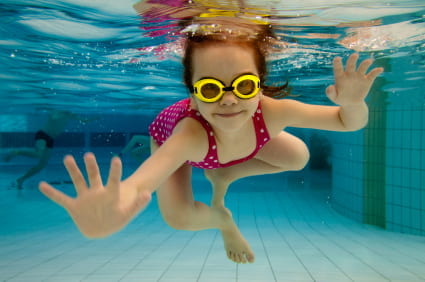By Kerri Kreh Reda, M.P.H.
Each year, nearly 1,000 children ages 14 and younger drown. Those most at risk are children ages 4 and younger. Young children can drown in only an inch of water – therefore ponds, fountains, streams, creeks, storm drains, and buckets are all potential hazards.
Here are some water safety tips from the American Academy of Pediatrics
For the pool:
- Never leave children alone in or near water.
- Whenever infants or toddlers are in or around water, an adult who knows how to swim and perform CPR should be within arm’s length, providing “touch supervision.”
- Install a fence at least 4 feet high around all four sides of the pool. The fence should not have openings or protrusions that a young child could use to get over, under, or through.
- Make sure pool gates open out from the pool, and self-close and self-latch at a height children can’t reach. Consider alarms on the gate to alert you when someone opens the gate. Consider surface wave or underwater alarms as an added layer of protection.
- If the house serves as the fourth side of a fence surrounding a pool, install an alarm on the exit door to the yard and the pool. For additional protection, install window guards on windows facing the pool. Drowning victims have also used pet doors to gain access to pools. Keep all of your barriers and alarms in good repair with fresh batteries.
- Keep rescue equipment (a shepherd’s hook – a long pole with a hook on the end — and life preserver) and a portable telephone near the pool. Choose a shepherd’s hook and other rescue equipment made of fiberglass or other materials that do not conduct electricity.
- Avoid inflatable swimming aids such as “floaties.” They are not a substitute for approved life vests and can give children and parents a false sense of security.
- Children ages 1 to 4 may be at a lower risk of drowning if they have had some formal swimming instruction. However, there is no evidence that swimming lessons or water survival skills courses can prevent drowning in babies younger than 1 year of age.
- Avoid entrapment: Suction from pool and spa drains can trap a swimmer underwater. Do not use a pool or spa if there are broken or missing drain covers. Ask your pool operator if your pool or spa’s drains are compliant with the Pool and Spa Safety Act. If you have a swimming pool or spa, ask your pool service representative to update your drains and other suction fitting with anti-entrapment drain covers and other devices or systems.
- Children may fall in if they lean against the soft side of an inflatable pool. Although such pools are often exempt from local pool fencing requirements, it is essential that they be surrounded by an appropriate fence, just as a permanent pool would be, so that children cannot gain unsupervised access.
- If a child is missing, look for him or her in the pool or spa first.
- Share safety instructions with family, friends, and neighbors.
On the boat:
- Children should wear life jackets at all times when on boats or near bodies of water.
- Make sure the life jacket is the right size for your child. The jacket should not be loose. It should always be worn as instructed with all straps belted.
- Blow-up water wings, toys, rafts, and air mattresses should not be used as life jackets or personal flotation devices. Adults should wear life jackets for their own protection, and to set a good example.
- Adolescents and adults should be warned of the dangers of boating when under the influence of alcohol, drugs, and even some prescription medications.
At the beach:
- Never swim alone. Even good swimmers need buddies!
- A lifeguard (or another adult who knows about water rescue) needs to be watching children whenever they are in or near the water. Younger children should be closely supervised while in or near the water – use “touch supervision,” keeping no more than an arm’s length away.
- Make sure your child knows never to dive into water except when permitted by an adult who knows the depth of the water and who has checked for underwater objects.
- Never let your child swim in canals or any fast moving water.
- Ocean swimming should only be allowed when a lifeguard is on duty.
- Teach children about rip currents. If you are caught in a rip current, swim parallel to shore until you escape the current, and then swim back to shore.
For more tips on sun and water safety, visit www.healthychildren.org
Copyright © 2013 American Academy of Pediatrics. Please feel free to use tips in any print or broadcast story with appropriate attribution of source.
Kerri Kreh Reda, M.P.H., is a Human Development Specialist with Cornell Cooperative Extension of Suffolk County’s Family Health and Wellness Program. She can be reached at 631-727-7850 ext. 330 or at kkr5@cornell.edu.

The Child safety fence is so important. Always make sure that the pool water is clear so that anything that falls in the pool can be seen from the surface. In the summer the water can get cloudy and even green in 1 day if the chemicals in the water are not kept at the proper balance. I really think that a pool service is a good idea for the summer to keep the water clear and the fences locked.
don shumake
http://www.poolservicetemecula.org